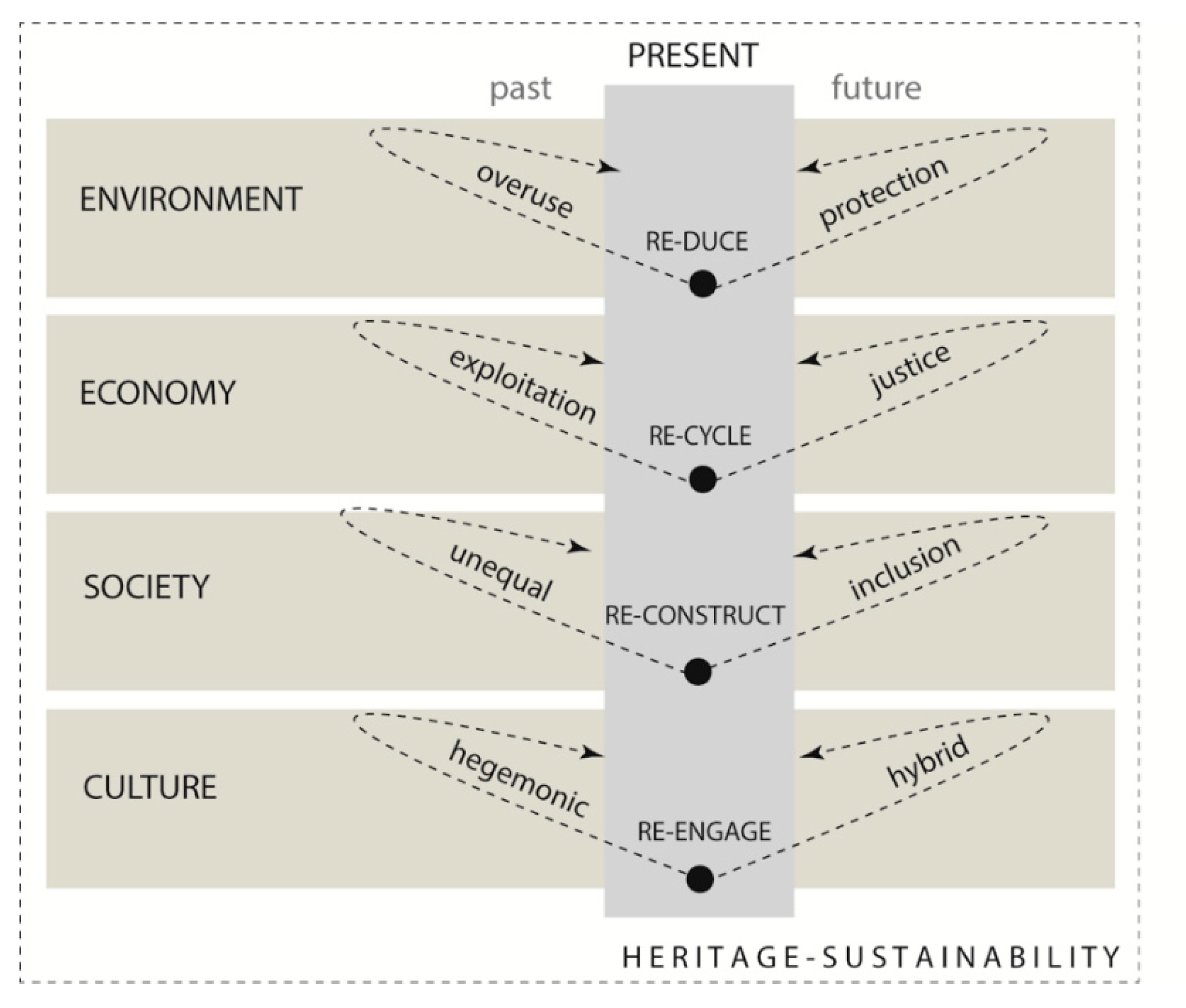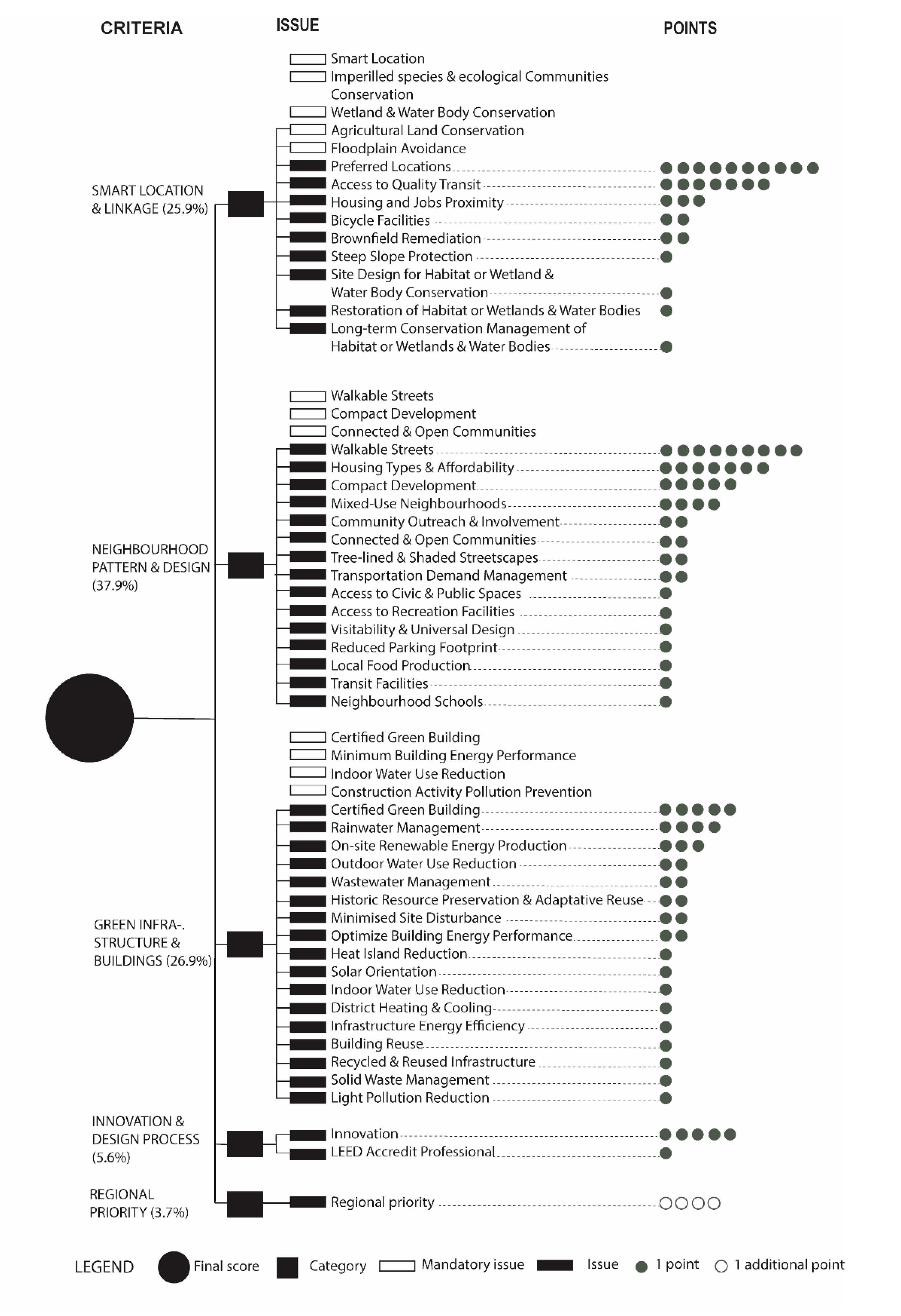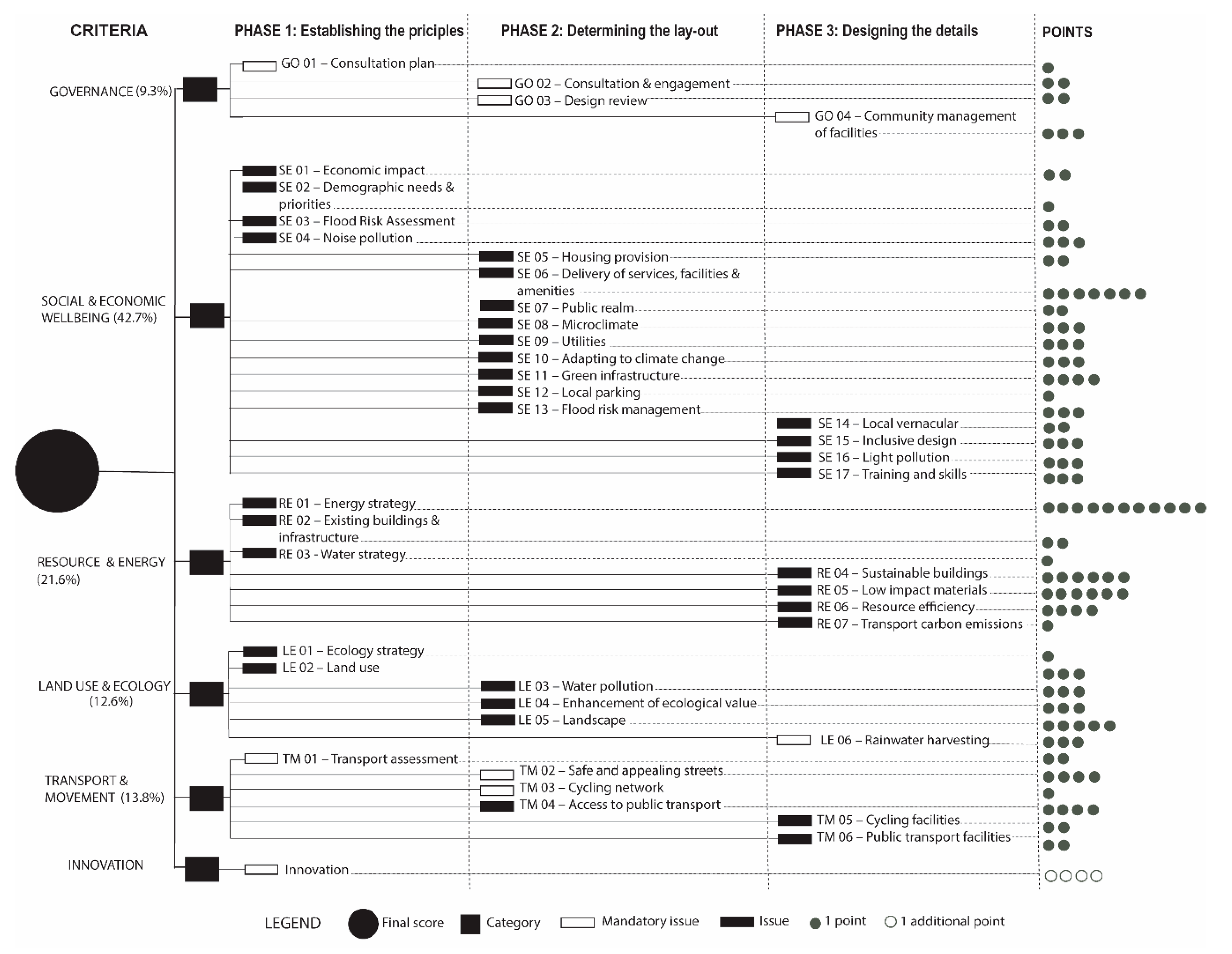Reviewing Neighborhood Sustainability Assessment Tools through Critical Heritage Studies
Abstract
1. Introduction
2. Heritage and Sustainability through the Lens of Critical Heritage Studies
2.1. Introducing Critical Heritage Studies
2.2. Linking Heritage to Sustainability
3. Introducing the Neighborhood Assessment Tools, BREEAM-C and LEED-ND
3.1. What Are NSAs?
3.2. BREEAM-C and LEED-ND
4. Research Methods and Material
5. The NSAs and their Conceptions of Heritage
5.1. How do the NSAs Talk about Heritage?
5.2. Nature–Culture
5.3. Formal–Informal
5.4. Artifacts–Practices
5.5. Spatial and Temporal Disconnectedness
6. Concluding Remarks
Author Contributions
Funding
Conflicts of Interest
References
- Winter, T. Clarifying the critical in critical heritage Studies. Int. J. Herit. Stud. 2013, 19, 532–545. [Google Scholar] [CrossRef]
- Ashworth, G.J. In search of the place identity dividend: Using heritage landscapes to create place identity. In Sense of Place, Health and Quality of Life; Ashgate Publishing: Farnham, UK, 2008; pp. 96–185. [Google Scholar]
- Moore, N.; Whelan, Y. Heritage, Memory and the Politics of Identity: New Perspectives on the Cultural Landscape, 2nd ed.; Routledge: New York, NY, USA, 2016. [Google Scholar]
- Evans, K.; Fraser, P.; Taylor, I. A Tale of Two Cities: Global Change, Local Feeling and Everday Life in the North of England: A Study on Manchester and Sheffield; Routledge: London, UK, 1996. [Google Scholar]
- Seymour, L. Nature and Psychological Well-Being; English Nature: London, UK, 2003. [Google Scholar]
- Holman, N. Incorporating local sustainability indicators intro structures of local governance, a review of the literature. Local Environ. 2009, 14, 365–375. [Google Scholar] [CrossRef]
- Turcu, C. Re-thinking sustainability indicators: Local perspectives of urban sustainability. J. Environ. Plan. Manag. 2013, 56, 695–719. [Google Scholar] [CrossRef]
- Harrison, R. Beyond “Natural” and “Cultural” Heritage: Toward an Ontological Politics of Heritage in the Age of Anthropocene. Herit. Soc. 2015, 8, 24–42. [Google Scholar] [CrossRef]
- Smith, L. Uses of Heritage; Routledge: London, UK, 2006. [Google Scholar]
- Harvey, D.C. Heritage Pasts and Heritage Presents: Temporality, meaning and the scope of heritage studies. Int. J. Herit. Stud. 2001, 7, 319–338. [Google Scholar] [CrossRef]
- Borges, L.A. Stories of Pasts and Futures in Planning. Ph.D. Thesis, Royal Institute of Technology, Stockholm, Sweden, 2016. [Google Scholar]
- Holtorf, C.; Högberg, A. Contemporary Heritage and the Future. In Palgrave Handbook of Contemporary Heritage Research; Palgrave Macmillan: London, UK, 2015. [Google Scholar]
- Harrison, R. Heritage Critical Approaches; Routledge: New York, NY, USA, 2013. [Google Scholar]
- Descola, P. Beyond Nature and Culture; The University of Chicago Press: Chicago, IL, USA; London, UK, 2013. [Google Scholar]
- Latour, B. Reassembling the Social: An Introduction to Actor-Network Theory; Oxford University Press: Oxford, UK, 2005; ISBN 0-19-925605-5. [Google Scholar]
- Fouseki, K.; Nicolau, M. Urban Heritage Dynamics in ‘Heritage-Led Regeneration’: Towards a Sustainable Lifestyles Approach. Hist. Environ. Policy Pract. 2018, 9, 229–248. [Google Scholar] [CrossRef]
- Ashworth, G.J. Building a New Heritage: Tourism, Culture, and Identity in the New Europe; Larkham, P.J., Ed.; Routledge: Abingdon, UK, 1994. [Google Scholar]
- UNESCO. UNESCO Universal Declaration on Cultural Diversity; UNESCO: Paris, France, 2001. [Google Scholar]
- UNESCO. Convention on the Protection and Promotion of the Diversity of Cultural Expressions; UNESCO: Paris, France, 2005. [Google Scholar]
- UCLG. Culture: Fourth Pillar of Sustainable Development; United Cities Local Governments: Barcelona, Spain, 2010. [Google Scholar]
- Clark, K.; Clark, C. Only connect—Sustainable development and Cultural heritage. In The Heritage Reader; Routledge: Abingdon, UK; New York, NY, USA, 2008; pp. 82–98. [Google Scholar]
- Borges, L.A. Using the past to construct territorial identities in regional planning: The case of Mälardalen, Sweden. Int. J. Urban Reg. Res. 2017, 41, 659–675. [Google Scholar] [CrossRef]
- Borges, L.A.; Adolphson, M. The Role of Official Heritage in Regional Spaces. Urban Res. Pract. 2016, 9, 290–310. [Google Scholar] [CrossRef]
- Ijla, A.; Broström, T. The Sustainable Viability of Adaptive Reuse of Historic Buildings: The experiences of Two World Heritage Old Cities; Bethlehem in Palestine and Visby in Sweden. Int. Invent. J. Arts Soc. Sci. 2015, 2, 52–66. [Google Scholar]
- Harvey, D.C. Heritage and scale: Settings, boundaries and relations. Int. J. Herit. Stud. 2015, 21, 577–593. [Google Scholar] [CrossRef]
- Hammami, F. Conservation, innovation and healing of the well-preserved medieval Ystad. J. Urban Res. Pract. 2015, 8, 165–195. [Google Scholar]
- Raworth, K. A Safe and Just Space for Humanity; Oxfam International: Oxford, UK, 2012. [Google Scholar]
- Muilerman, H.; Blonk, H. Towards a Sustainable Use of Natural Resources; Stichting Natuur en Milieu: Utrecht, The Netherlands, 2001. [Google Scholar]
- Steffen, W.; Richardson, K.; Rockstrom, J.; Cornell, S.E.; Fetzer, I.; Bennett, E.M.; Sorlin, S. Planetary boundaries: Guiding human development on a changing planet. Science 2015, 347. [Google Scholar] [CrossRef] [PubMed]
- Wijkman, A.; Skånberg, K. The Circular Economy and Benefits for Society Jobs and Climate Clear Winners in an Economy Based on Renewable Energy and Resource Efficiency; A study pertaining to Finland, France, The Netherlands, Spain and Sweden; Club of Rome: Rome, Italy, 2016. [Google Scholar]
- Prendeville, S.; Cherim, E.; Bocken, N. Circular cities: Mapping six cities in transition. Environ. Innov. Soc. Transit. 2018, 26, 171–194. [Google Scholar] [CrossRef]
- Agyeman, J. Sustainable Communities and the Challenge of Environmental Justice; NYU Press: New York, NY, USA, 2005; ISBN 0-8147-0728-9. [Google Scholar]
- Agyeman, J.; Schlosberg, D.; Craven, L.; Matthews, C. Trends and Directions in Environmental Justice: From Inequity to Everyday Life, Community, and Just Sustainabilities. Annu. Rev. Environ. Resour. 2016, 41, 321–340. [Google Scholar] [CrossRef]
- Sharifi, A.; Murayama, A. A critical review of seven selected neighbourhood sustainability assessment. Environ. Impact Assess. Rev. 2013, 38, 73–87. [Google Scholar] [CrossRef]
- Sharifi, A.; Murayama, A. Neighborhood sustainability assessment in action: Cross-evaluation of three assessment systems and their cases from the US, the UK, and Japan. Build. Environ. 2014, 38, 243–258. [Google Scholar] [CrossRef]
- Berardi, U. Sustainability assessment of urban communities through rating systems. Environ. Dev. Sustain. 2013, 15, 1573–1591. [Google Scholar] [CrossRef]
- Zhou, C.; Dai, X.; Wang, R.; Huang, J. Indicators for Evaluating Sustainable Communities: A Review. Shengtai Xuebao/Acta Ecol. Sin. 2011, 31, 4750–4759. [Google Scholar]
- Wangel, J.; Wallhagen, M.; Malmqvist, T.; Finnveden, G. Certification systems for sustainable neighbourhoods: What do they really certify? Environ. Impact Assess. Rev. 2016, 56, 200–213. [Google Scholar] [CrossRef]
- Haapio, A. Towards sustainable urban communities. Environ. Impact Assess. Rev. 2012, 32, 165–169. [Google Scholar] [CrossRef]
- Cohen, M. A Systematic Review of Urban Sustainability Assessment Literature. Sustainability 2017, 9, 2048. [Google Scholar] [CrossRef]
- Lind, J.; Malmqvist, T.; Wangel, J. Key Considerations When Designing Certification Systems for Urban Sustainability and Implications for The Swedish Post-Construction System Citylab. Sustainability 2019, 11, 2673. [Google Scholar] [CrossRef]
- Kyrkou, D.; Karthaus, R. Urban sustainability standards: Predetermined checklists or adaptable frameworks? Procedia Eng. 2011, 21, 204–211. [Google Scholar] [CrossRef]
- BRE Global. Achieving Sustainable Masterplans—BREEAM Communities; BRE Global: Watford, UK, 2018. [Google Scholar]
- BRE Global. BREEAM Communities Technical Manual; BRE Global: Watford, UK, 2017. [Google Scholar]
- USGBC. LEED v4 for Neighborhood Development; U.S. Green Building Council: Washington, DC, USA, 2018. [Google Scholar]
- USGBC. LEED—Reference Guide for Neighborhood Development; U.S. Green Building Council: Washington, DC, USA, 2014. [Google Scholar]
- Ashworth, G.J. Preservation, conservation and heritage: Approaches to the past in the present through the built environment. Asian Anthropol. 2011, 10, 1–18. [Google Scholar] [CrossRef]
- Holtorf, C. On Pastness: A Reconsideration of Materiality in Archaeological Object Authenticity. Anthropol. Q. 2013, 86, 427–444. [Google Scholar] [CrossRef]
- Guy, S.; Marvin, S. Understanding Sustainable Cities: Competing Urban Futures. Eur. Urban Reg. Stud. 1999, 6, 268–275. [Google Scholar] [CrossRef]
- Hammami, F. Heritage in Authority-Making: Appropriating Interventions in Three Socio-Political Contexts; Royal Institute of Technology: Stockholm, Sweden, 2012. [Google Scholar]



© 2020 by the authors. Licensee MDPI, Basel, Switzerland. This article is an open access article distributed under the terms and conditions of the Creative Commons Attribution (CC BY) license (http://creativecommons.org/licenses/by/4.0/).
Share and Cite
Aguiar Borges, L.; Hammami, F.; Wangel, J. Reviewing Neighborhood Sustainability Assessment Tools through Critical Heritage Studies. Sustainability 2020, 12, 1605. https://doi.org/10.3390/su12041605
Aguiar Borges L, Hammami F, Wangel J. Reviewing Neighborhood Sustainability Assessment Tools through Critical Heritage Studies. Sustainability. 2020; 12(4):1605. https://doi.org/10.3390/su12041605
Chicago/Turabian StyleAguiar Borges, Luciane, Feras Hammami, and Josefin Wangel. 2020. "Reviewing Neighborhood Sustainability Assessment Tools through Critical Heritage Studies" Sustainability 12, no. 4: 1605. https://doi.org/10.3390/su12041605
APA StyleAguiar Borges, L., Hammami, F., & Wangel, J. (2020). Reviewing Neighborhood Sustainability Assessment Tools through Critical Heritage Studies. Sustainability, 12(4), 1605. https://doi.org/10.3390/su12041605




